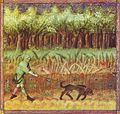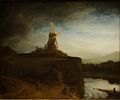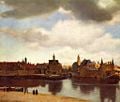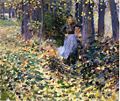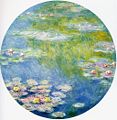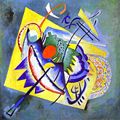Landscape painting (European tradition)
Landscape Painting depicts the scenery of the European natural world with the views that impact the artist's eye. In an effort to represent the beauty that meets the eye, the artist tries to capture that fleeting moment in time and space, for all time, thus becoming a co-creator along with the original Creator.


Nature as Divine Power
Early in the fifteenth century, Landscape painting was established as a genre in Europe, as a setting for human activity, often expressed in a religious subject, such as the themes of the Rest on the Flight into Egypt, the Journey of the Magi, or Saint Jerome in the Desert.
With Christian religion came the idea of nature as a manifestation of divine power. This led to the symbolic view of nature, from the 'real to the 'unreal' landscapes of Byzantine art. Later the first realistic scapes came from Siena, with Ambrogio Lorenzetti's frescoes. Avignon was also a center of factual landscape detail in the decorative walls at the Palace of the Popes, 1343. In the north, in France and Burgundy, manuscripts such as the Tres Riches Heures by the Duke of Berry (Book of the Hours) created as seasonal calendars and painted by artists from the Low Countries showing nature in miniature perfection and this style inspired the Italians.
The Northern or Gothic style
In the North, Gothic painters such as Jan van Eyck could give their landscapes luminosity while others, a sharp exactitude. A hard crisp style, as with Robert Campin's work, after Pol de Limburg and this worked well to depict harsh winter landscapes. Albrecht Durer's topographical scenes, around 1494, show an intense uncompromising gaze and his drawing of Innsbruck is perhaps the first real portrait of a town.
Flemish does not always mean naturalistic. When we witness the works of Hieronymus Bosch, for example, The Garden of Earthly Delights, 1503-1504, Oil on wood, we see a world purely of the imagination, made from religious faith. He was to portray both, Heaven and Hell.
Geographically, Romanticism is a Northern European extreme and Classicism, a Southern. This has a lot to do with climate and light and the artist's reaction to it. Of course, the styles may be fused in the best of those artists.
The Renaissance
In Italy, Giovanni Bellini was perhaps the first to mold all the varying styles of precision and mastery of light into one harmonious whole with man, nature and his environment seen on equal terms. The Renaissance produced both Christian and Pagan symbols along with Classical mythology, to praise man rather than any one system. A shift from divine to earthly love is shown in portrayals by both Botticelli and Titian. Artists began to look at the landscape in a much more studied and scientific way, tired of the old symbolic representations of nature. Leonardo da Vinci studied closely and drew, rocks and the way water and clouds move and botanicals among other subjects, in his Notebooks.
Out of the strong came forth sweetness, wrote Walter H. Pater, 1839-1894, an English essayist on art, of the influence of Florence on the Renaissance.
Whilst Northern painters such as Hubert van Eyck intuited the natural regression in space, a rational Italian, an architect, Brunelleschi, created scientific perspective with strict laws of vanishing points and upright verticals, to control use of space. Paradoxically, the ancient Chinese had the exact opposite way of working. Florence discovered perspective which organized space, whilst the Netherlands discovered light, which unified it. Masaccio and the van Eyck brothers were the chief exponents of this.

'Mountains, in consequence of the great quantity of atmosphere between your eye and them, will appear blue', writes Leonardo da Vinci, in the Notebooks. We witness the luminous mists on rocky mountains in his Mona Lisa, 1505, oil on wood.
Piero della Francesca with his simple control of form and beautifully balanced picture of the world, Allegorical Triumph of Battista Sforza, Tempera and oil on wood, was able to combine both Flemish and Florentine styles. Andrea Mantegna, Landscape with a Castle Under Construction, Fresco, showed how perspective could give sculptural depth and drama to a picture. Giorgione, 1478-1510, the master of the poetic landscape, displayed great painterly skill along with an ambiguous dream like quality, as in, The Three Philosophers, 1508-1509, Oil on canvas. Raffaello Sanzio's Madonna di Foligno, 1511-1512, Transferred from wood to canvas, is close to fact although he saw every aspect of nature as a manifestation of the Divine.
The experiments and new incursions into landscape painting during the Renaissance helped raise up the genre until in the nineteenth century it would finally come into it's own. Leonardo assisted this by stressing that the artist should work with his mind as much as his eye and get away from the idea of being a mere illustrator or copyist.
Anticipating future artists
Titian's landscapes of his native Cadore, Ruggero and Angelica in a Landscape, Pen and brown ink, with clumpy trees, rushing streams and vivid blue hills, are echoed in countless landscapes through the ages, especially in both John Constable's and J.M.W. Turner's work in England.
During the French Baroque Era, Claude Lorrain's, 1600â1682, glowing paintings, had a transcendental feeling of the perfect and came from direct observations of nature whilst Nicolas Poussin (1648) had a strict geometry and he believed in a moral character in painting and wanted to control nature with intellectual creativity and many artists studied and tried to emulate these artists, including those in the nineteenth and twentieth centuries.
Spiritual Reaction
Mannerism was a reaction to the Renaissance, a way to depict Spirituality over Humanism. A form of Expressionism, it had a love of visual excitement akin to the Gothic tradition, everything was for effect. Tintoretto, Saint Mary of Egypt in Meditation, 1585, Oil on canvas and El Greco, the Greek, 1541-1614, View of Toledo, Oil on canvas, were great examples. Peter Paul Rubens', 1577-1640, landscapes were full of both naturalism and romantic escapism. The Hurricane, 1624, oil on wood, is typical and his rainbows anticipated Turner.
The Northern naturalism

Sixteenth- century Flemish landscape began with Joachim Patinir and lasts over a hundred years and ends with the refined Jan Breughel the Elder, or Velvet or Flower Breughel, with sublime religious subjects, as in, Sodom and Gomorrah, oil on copper. His father, Pieter Breghel the Elder, or Peasant Breughel (for his portrayals of that life) was considered the greatest of Flemish painters of the period with his combination of Italian maniera or style and Netherlands realism. Hunters in the Snow, 1565, Oil on wood is believed to be, December or January, from a series of the Months.
Dutch painters soon moved towards a new naturalism unhampered by literary or classical allusions. This commitment to landscape for its own sake was novel in it's time. Light became the dominant theme and realism needed by a newly rich class. These were the honest tributes to this Northern landscape of flat fields and low skies. The new Dutch style began with Hercules Seghjers of Haarlem, 1590-1638, with a kind of imaginative realism as in, Rocky Landscape, Oil on canvas, and a golden light that Rembrandt admired, owning several of his work.
Names such as Esias van der Velde and Jan van Goyen developed such themes from around 1615 and Jacob von Ruisdael, with The Beach at Egmond-aan-Zee, Oil on canvas. de Konink, Cuyp and Meindert Hobbema, with, Avenue Middelharnis, 1689, Oil on canvas, also contributed to the naturalistic movement. Rembrandt added his own ideal paintings of sombre force, with his supreme genius, in a few oils, he rearranged nature drastically, vis a vis, The Stone Bridge, 1638/1640, oil on wood, Jan Vermeer's masterpiece, View of Delft, 1660, oil on canvas, is a well planned painting with an incredible subtle variety of tone.
The new French and English Schools
In France during the reign of Louis XIV, the argument as to which was more important, color or drawing came to a head. The partisans of drawing favored Poussin, whilst those of color, Rubens. This battle was won when, a product of the Rococo period, Antoine Watteau was accepted into the French Academy in 1717, with his Embarkation for Cythera. This painting has wistful lovers in a theatrical tableau and it began the career of the most famous French colorist and painter of lovers and musicians of the eighteenth century. This later led to the idylls of Jean-Honore Fragonard, 1732-1806, the last great painter of the eighteenth century, who along with Watteau, seemed to consider nature as well-tended parks and gardens and the latter contemplated the world with more than delight and painted it with freshness and freedom. The Shady Avenue, 1736-1776, Oil on wood, a fine example.
Thomas Gainsborough, a portraitist, in England, belonged to a period in which his fellow countrymen tried to make actual 'places' into living versions of classical paintings. When these formal gardens were then used as starting points of landscape paintings, history had gone full circle, as in Landscape with a Bridge, after 1774, oil on canvas.
In the nineteenth century, Romanticism, the opposite of classicism or neo-classicism began to take on a variety of meanings and introduced the idea of the sublime. This, was to bring forth the ideal of feeling, as to opposed to cold reason. This resulted in very dramatic works, later echoed in some of the Hudson Valley painters in America. James Ward, 1769-1859, painted Gorsdale Scar in Yorkshire, exaggerating an already spectacular piece of scenery. John Martin, in The Bard, before 1817, oil on canvas, turns to literary and dark medieval legends, whose figures are dwarfed by fantastic mountain-scapes and whose mezzo-tints were to have a direct impression on the Hudson River School in America.
Joseph Mallard William Turner, 1775-1881, stated around 1810:
"To select, combine, that which is beautiful in nature and admirable in art, is as much the business of the landscape painter, in his line, as in other departments of art."
Turner typifies the best of the English landscape school in that he was brought up on the classical patterns which he mastered and then went on to develop his own completely personal style. One that we could call Romantic and poetic as he was often given to allegory. He dealt in 'essences' especially as a master of watercolor. Turner was probably the greatest landscape and seascape painter of all time and perhaps no other evolved over a greater visual span, than he. From the early masterworks such as the Fishermen at Sea, 1796, Oil on canvas, to the 1840s and the Falls of the Clyde, Oil on canvas, after an earlier, watercolor, there is a vast difference, that they hardly seem to be by the same hand. The dazzling color and high tonality of the late works seem to anticipate the Impressionists and in his final phase one can almost call this work, abstract. His profound continuity however, shows how single-mindedly he pursued his early goals and how brilliantly he finally attained them. He was the first to have his paintings hung low, as history paintings were, so that they could be viewed, as if entering them, rather than being hung, as if, altar pieces. Landscape was no longer to be seen from afar but had as an immediate experience. Watercolor was his great forte and is part of the English tradition of watercolor continued by John Sell Cotman, of Norfolk, 1782-1842, with his neatness and vigor.

Out of that East Anglia tradition came the great English landscapist, John Constable, 1776-1837, a naturalist and whilst Turner was being operatic he was being domestic. His country scenes are popular throughout the world. The Haywain was exhibited at the Paris Salon in 1824 and made an instant impact. His hard work, inspired by the Dutch, had him making quick impressions and oil sketches before working them up in detail in oils. Constable never went abroad, for his love of his native Suffolk; "those scenes made me a painter and I am grateful."
From this influence came Theodore Rousseau of the Barbizon School, named after a village near the forest of Fontainbleau, a group of radical, plein air painters. He treated trees with great reverence, attempting to reveal their psychology and was influenced by both Constable and the Dutch, resulting in works like, Pond with Oak Trees, 1865-1869, oil on canvas. He, with others, made an almost religious cult of nature. Leaving the unreality of urban life, they equated it with high moral values. Jean Francois Millet, 1814-1875, saw the country as a work place, he glorified the hard life of the peasant, whose stock he too came from. Towards the end of his life he made purely landscape and his beautiful and dramatic, Spring, 1868-1873, oil on canvas, suggests the world of Symbolism. From this group, Camille Corot, a tonal, subtle colorist was very different, preferring his own compromise between classicism and natural observation, Cornfield in the Morvan, 1842, Oil on canvas. He was to have an influence later, on the Luminists in America, with his shimmering light through feathery willow trees. Gustave Courbet however, was more direct with brash color and form, as in Roe Deer in a Forest, 1866, oil on canvas. His ideas were political, seeing art as art of the 'people'. as was Millet. As a group they anticipated the Impressionists by working outdoors without recourse to the studio, plein air.
The Romantic North
In Northern countries the Romantic view of nature varied enormously. Painters either were sternly realistic or tried to show off the characteristic beauties of their country. German artist, Caspar David Friedrich, 1774â1840, was the exception and the greatest exponent of the Romantic landscape in northern Europe. Mountain Landscape with Rainbow, 1809, oil on canvas, conveys a sense of mystery of the bewilderment of man confronted with the huge Creation. His conveyance of the romantic and the sublime also had great influence later in American painting as with the English painter, John Martin.
The Impressionists and Post-Impressionists

From a small exhibition given by a few close friends working in the same way together, came the name for their genre. The freshness and immediacy of execution, shocked the public and the neglect of proper 'subjects' by Monet, Pissarro, Sisley and Cezanne. Monet's Impression: Sunrise gave rise to the sarcastic comment, "an exhibition of impressionists."
When the Impressionists were at their best, they wove a pattern of light and shade over their canvases, eliminating hard outlines and graded shading. Their sheer use of pure color would have amazed their predecessors. Black and brown were removed for color absorbed them. Claude Monet 1840-1926, profited from working with Pierre-Auguste Renoir, 1841-1919, who'd been a painter of china. As plein air artists they'd finish canvases in their studios, with Monet's on a house boat at one point. Friends and others; Camille Pissaro, L'Hermitage, Pontoise, 1873, (oil on canvas), Pierre-August Renoir, 1874, oil on canvas, Alfred Sisley, Flood at Le Port-Marly 1876, (oil on canvas), and Edouard Manet, The Swallows, (The Artist's Wife and Mother) 1873, (oil on canvas), are remembered for their work in this genre and all influenced each other. Monet really stands out as the leader and innovator. His late work, enormous canvases of Waterlilies that were a part of his beloved gardens, would be a foretaste of Modern abstractionists to come. "Monet is only an eye but what an eye!" declared Paul Cezanne.
The Japanese influence
Japanese woodcut prints (in the ukiyo-e or the Floating World genre) were very popular at this time. Monet owned many and they influenced many artists and especially, Vincent Van Gogh, Paul Gaughin, Manet and Edgar Degas, all who included references to them in their paintings.
A master whose work showed them a new way to organize their subjects in space, Katsushika Hokusai (1760-1849) made a print, Fuji which was a design of calligraphic brilliance and demonstrated a fleeting moment captured in an eternal pattern.
Impressionism's influence
Other nations were influenced by this style including America, especially Childe Hassam. An American living in London, James Abbott McNeill Whistler had success with his beautiful Nocturne in Blue and Gold: Old Battersea Bridge, 1870-1902, oil on canvas.
Another American staying in England, John Singer Sargeant, 1856-1925, known primarily as a portraitist, was also an excellent realist, landscape painter and embraced some of Impressionism's ideal of capturing the quality of light, which he did with his unique method of small flickering streaks of brilliant color, as in Home Fields, 1885, oil on canvas. He even had the opportunity to capture Monet painting in a work, Claude Monet, Sketching at the Edge of a Wood, ca. 1887, oil on canvas. In later life he again made his name with watercolors of European scenes. In France, Homer Dodge Martin, 1836-1897, the oldest American Impressionist, a Hudson River artist, went to Paris at age of 40 and Theodore Robinson was an ardent supporter of Monet and stayed with him in Giverny. Mary Cassatt, born in Pittsburgh but educated in France, lived there and painted many fine mother and child portraits. A friend of Degas she is considered more of a post-impressionist and painted but a few landscapes. In Italy, sculptor and painter, Adriano Cecioni said, "From the point of view of art, everything is beautiful." After the unification of Italy, the new realistic painters became, in 1861, the macchialli from their macchie or patches of color.

Between, 1880 and 1886, Impressionism declined, as some were seeking a scientific solution to the problem of light, which the older painters had worked out through feeling rather than reason.
Laboratory analysis of the spectrum gave rise to a new technique, known as pointillism in France and divisionismo in Italy. George Seurat showed Sunday afternoon at the the Island of La Grande Jette, in 1886 (oil on canvas) with vibrant light distilled all over, at the final Impressionism exhibition. Paul Signac, 1863-1935, was Seurat's devoted disciple but more lyrical and less restricted. Cote d'Azure, 1889 (oil on canvas) is an example.
Post-Impressionists such as Paul Cezanne began to explore the landscape in even different ways. His geometric, almost cubist, views of his beloved Provence, The Rocky Landscape at Aix and Lake Annecy, 1895 (oil on canvas) where the line is never static. He wished to catch the fleeting moment, as did his peers but now to objectify it, make it as solid as the art in museums. 'Where to put the line? the light moves, I move, everything is movement', he declared. This was serious work, not the lighthearted world of the Impressionists.
Symbolism
Symbolism came as a reaction to naturalism and Impressionism, trying to make a synthesis between nature and the artist's personal idea. The Pont-Aven school, in Brittany, used this idea in landscape and revolved around Paul Gaughin, 1848-1903. Using the techniques of Emile Bernard; large flat areas of color often with dark outlines, not unlike stained glass, as in Les Alyscamps, 1888 (oil on canvas). After a spell living with Van Gogh in Provence, Gaughin journeyed to Panama and finally ended his days in Tahiti. "Dream in the presence of nature," he told others and he painted idyllic native scenes such as The Day of God (Mahana Atua) somewhat recalling Egyptian friezes, in their flatness. In Provence, his colleague, the Dutchman, Vincent Van Gogh, an artist of religious fervor, whose undiagnosed and severe illness drove him to tormented landscapes of brilliant color and whirling lines as in; Cypresses, 1889 (oil on canvas) and the unforgettable Sunflowers until finally suicide ended his young life. Supported by a brother, Theo, an art dealerin Paris, he was to only sell one painting through his years of toil. However, his letters, explaining his thoughts on painting are well read, today, whilst his paintings command high prices. In Paris, 'La Douanier' (the customs officer) self-taught, Henri Rousseau, charmed all with his simple but completely imaginary, exotic excursions, as in The Merry Pranksters, 1906 (oil on canvas). Sometimes known as a naif he was a great and original painter in his own right.
Freedom in the Twentieth Century
Freed from many old constraints, artists began to experiment more and more, with happy results; Henri Matisse, 1869-1954, a brilliant colorist with, The Blue Room, The Bluff, 1907 (oil on canvas) and a leading spirit of the the Fauves or "wild beasts," with vivid and highly decorative motifs, Raoul Dufy with sketchy frivolity and decorative color, Maurice Utrillo and his beloved Paris-scapes, Vlaminck (1876-1958) laying on thick layers of oil with a knife, etc.
After generations of painters had solved all the problems of realism, illusions of reality, space and light having been conquered, painters had the choice of starting from scratch as did the Cubists or making the essences of landscape by abstraction, etc. Cubism was a continuation of Cezannes' explorations, breaking down the landscape into geometric forms, as created in France, by Georges Braque, Houses at L'Estaque, 1908 (oil on canvas) and Pablo Picasso, in Spain and France, Factory at Horta de Ebra, 1909 (oil on canvas). In Italy, Futurism was on the rise, led by Giacomo Balla, with its synthesized color and movement. Paul Klee, a Swiss, Terraced Garden, 1920 (oil on cardboard) explored an organic and whimsical world, whilst Klimt, in Austria, Chateau Above the Lake 1908 and Marc Chagall, in The Repose of the Poet captured landscapes in fantasy and realism combined. Then came the mental masters, the Surrealists striving to take the landscape further with the imagination than ever. Salvador Dali in Spain and France with Atavistic Images After the Rain, 1934 (oil on canvas) with an incredible technical facility and inventiveness to match. Rene Magritte in Belgium, The Castle of the Pyrenees, 1959 (oil on canvas) whose realistic subjects are juxtaposed in strange but not unpleasant directions, are two of the moderns who won our hearts and minds.
Moderns at the beginning of this century who helped free our concepts are; the Russian, Vasily Kandinsky, of the Blaue Reiter group with The Blue Rider, 1903 (oil on canvas) and Impression V (The Park) 1911 (oil on canvas) the first of the abstractionists, Piet Mondrian, Dutch, The Tree 1912 (oil on canvas) Umberto Boccioni, Italy, Morning 1909 (oil on canvas). Later came; Franz Marc Roe Deer in the Wood, 1913-1914 (oil on canvas) Oscar Kokoschka, Austria, Tre Croci Pass in the Dolomites, 1913 (oil on canvas) Giorgio Morandi, Italy, Landscape 1925 (oil on canvas) Max Ernst, Germany, Europe After the Rain 1940-1942 (oil on canvas) Graham Sutherland, England, Welsh Landscape 1973 (oil on canvas) Jean Dubuffet, Ice Landscape (Opal) 1954 (oil on canvas) etc.
The tumultuous twentieth Century ended with a multitude of artists going in endless directions. However, Europe had given America it's inspiration and New York City soon became the center of the Art World, leaving Paris far behind. The European tradition, however, lives on, with the artists and paintings of the new paradise. The popular Bernard Buffet, France, 1928-1999, with his black outlines, reminiscent of Georges Rouault, a religious painter, of Christs and clowns, 1871-1958, and stained glass, kept the vision of his beloved capital alive, telling us, "Painting, we do not talk about it, we do not analyze it, we feel it."
Gallery
The Mill, by Rembrandt van Rinj, 1645
View of Deft, by Johannes Vermeer, 1660â1661
Mountain Landscape with Rainbow, by Caspar David Friedrich, 1809
Boat-building near Flatford Mill, by John Constable, 1815
The wanderer above the sea of fog, by Caspar David Friedrich, 1818
The Admiral's House in Hampstead, by John Constable, 1822
Norham Castle, by Joseph Mallord William Turner, 1835-1840
The Fighting TĂ©meraire, Joseph Mallord William Turner, 1838
Impression, Soleil Levant by Claude Monet in 1872
Monet Painting in His Garden by Pierre-Auguste Renoir, 1873
Jas de Bouffan (The Pond), by Paul Cezanne, 1876.
The Swineherd, by Paul Gauguin, 1888
Mont Sainte-Victoire, by Paul Cezanne, 1890
Tahitian Landscape, by Paul Gauguin, 1893
Water lilies, by Claude Monet in 1908
Red Oval, by Wassily Kandinsky, 1920
The Persistence of Memory, by Salvador DalĂ, 1931
ReferencesISBN links support NWE through referral fees
- Bazarov, Konstantin. Landscape painting. London: Octopus Books; NY: Mayflower Books, 1981. OCLC 8686498
- Brigante, Guiliano. The View Painters of Europe. Phaidon Press Ltd., 1979. ISBN 0714814075
- Carli, Enzo. The Landscape In Art, from 3,000 B.C.E. to Today Arnoldo Mondadori Editore S.p.A., Milano, 1979. English translation copyright Arnoldo Mondadori Editore S.p.A., Milano. ISBN 0688036783
- Clark, Sir Kenneth, Landscape into Art. Harper and Row, 1949. ISBN 0060107812
- Guggenhein Museum. Russia! Nine Hundred Years of Masterpieces and Master Collections. Guggenheim-Museum publications, 2005. ISBN 0892073292
- Jeffares, Bo. Landscape Painting. New York: Mayflower Books Inc., 1979. ISBN 0831754133
- Kiers, Judikje, and Tissink Fieke. The Golden Age of Dutch Art, Thames and Hudson Ltd., 2000. ISBN 0500237743
- Leonard, Elizabeth. Painting the Landscape. Watson-Guptill Publications, 1984. ISBN 0823036553
- Shanes, Eric. Turner The Masterwoks. Portland House, 1990. ISBN 0517015099
Credits
New World Encyclopedia writers and editors rewrote and completed the Wikipedia article in accordance with New World Encyclopedia standards. This article abides by terms of the Creative Commons CC-by-sa 3.0 License (CC-by-sa), which may be used and disseminated with proper attribution. Credit is due under the terms of this license that can reference both the New World Encyclopedia contributors and the selfless volunteer contributors of the Wikimedia Foundation. To cite this article click here for a list of acceptable citing formats.The history of earlier contributions by wikipedians is accessible to researchers here:
The history of this article since it was imported to New World Encyclopedia:
Note: Some restrictions may apply to use of individual images which are separately licensed.




